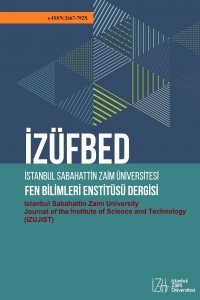Okul Öncesi Fen Eğitiminde Açık Kaynak Kodlu Planetaryumların Kullanılabilirliği
Açık kaynak kodlu yazılım, Planetaryum, Okul öncesi eğitim, Fen
The Usability of Open Source Planetariums in Preschool Science Education
Open source software, Planetarium, Preschool education, Science,
___
- Ampartzaki, M. & Kalogiannakis, M. (2016). Astronomy in early childhood education: A concept-based approach. Early Childhood Education Journal, 44, 169-179.
- Bozdoğan, A. E. (2020). ‘Planetaryum’ konusunda yayınlanan eğitim araştırmaları makalelerinin Web of Science veri tabanına dayalı bibliyometrik değerlendirilmesi. OPUS Uluslararası Toplum Araştırmaları Dergisi, 16(27), 150-173.
- Celestia. (2020). Erişim adresi https://celestia.space/.
- Demir, N. ve Öner Armağan, F. (2018). Okul dışı öğrenme ortamlarına yönelik fen bilgisi öğretmenlerinin görüşleri. Journal of Social and Humanities Sciences Research (JSHSR), 5(30), 4241-4248.
- Hu, J., Gordon, C., Yang, N., & Ren, Y. (2021). ‘Once Upon A Star’: A science education program based on personification storytelling in promoting preschool children’s understanding of astronomy concepts. Early Education and Development, 32(1), 7-25.
- Hughes, S. W. (2008). Stellarium–a valuable resource for teaching astronomy in the classroom and beyond. Science Education News (SEN), 57(2), 83-86.
- İzgi Onbaşılı, Ü. ve Siper Kabadayı, G. (2019). Okul öncesi dönemde çocukların astronomi konusunda temel kavramlarla ilgili bilgilerinin incelenmesi. Turkish Journal of Primary Education, 4(2), 85-97.
- Kallery, M. (2011). Astronomical concepts and events awareness for young children. International Journal of Science Education, 33(3), 341-369.
- Lind, K. K. (1999). Science in early childhood: Developing and acquiring fundamental concepts and skills, dialogue on early childhood science, mathematics, and technology education. Washington, DC: AAAS.
- National Research Council (2001). Astronomy and astrophysics in the new millennium. Washington, DC: The National Academies Press.
- Ogelman, H. G. (2012). Teaching preschool children about nature: A project to provide soil education for children in Turkey. Early Childhood Education Journal, 40(1), 77–185.
- Persson, J. R. and Eriksson, U. (2016). Planetarium software in the classroom. Physics Education, 51(2), 1-9.
- Sharp, J. G. (1999). Young children’s ideas about the Earth in space. International Journal of Early Years Education, 7(2), 159-172.
- Stellarium. (2020). Erişim adresi http://stellarium.org/.
- Timur, S., Yalçınkaya-Önder, E., Timur, B. ve Özeş, B. (2020). Astronomy education for preschool children: Exploring the sky. International Electronic Journal of Elementary Education, 12(4), 383-389.
- Zotti, G. & Wolf, A. (2019). Stellarium 0.19. 0 User Guide, 2019. Available at https://stellarium.org.
- Yayın Aralığı: Yılda 2 Sayı
- Başlangıç: 2019
- Yayıncı: İstanbul Sabahattin Zaim Üniversitesi
Okul Öncesi Fen Eğitiminde Açık Kaynak Kodlu Planetaryumların Kullanılabilirliği
Açık Kaynak Kodlu Taşıt Renk Tespit Yazılımı Geliştirilmesi
Kurumsal Yerel Ağ Üzerinde Merkezi IP Telefon Santrali Kurulumu
Bilgisayar Destekli Teknik Tasarım Dersleri için Açık Kaynak Kodlu Müfredat Önerisi
Fahri Anıl SELÇUK, Aydın Tarık ZENGİN
Salgın Hastalıklarla Mücadelede Açık Kaynak Kodlu Çözümler
Melike BEKTAŞ, Abdullah YAVUZ, Faruk BULUT
Açık Kaynaklı Gezgin Robotların Mühendislik Eğitiminde Kullanımı ve Örnek Bir Müfredat
Nötron Buharlaşma Tepkimelerinde Algıç Benzetimi ve Olay Üretimi için Veri Güdümlü GEANT4 Sınıfları
Oktay DOĞANGÜN, Mustafa Nizametin ERDURAN, Ferhat ÖZOK
Özgür ve Açık Kaynak Kodlu Yazılım Platformlarının Uygulamalı Yapay Zeka Eğitimlerine Katkısı
Hıdır SELÇUK, T. Çetin AKINCI, Şahin Serhat ŞEKER
Karanlık Madde Etkin Alan Teorisinde Simülasyon Araçları Uygulamaları
